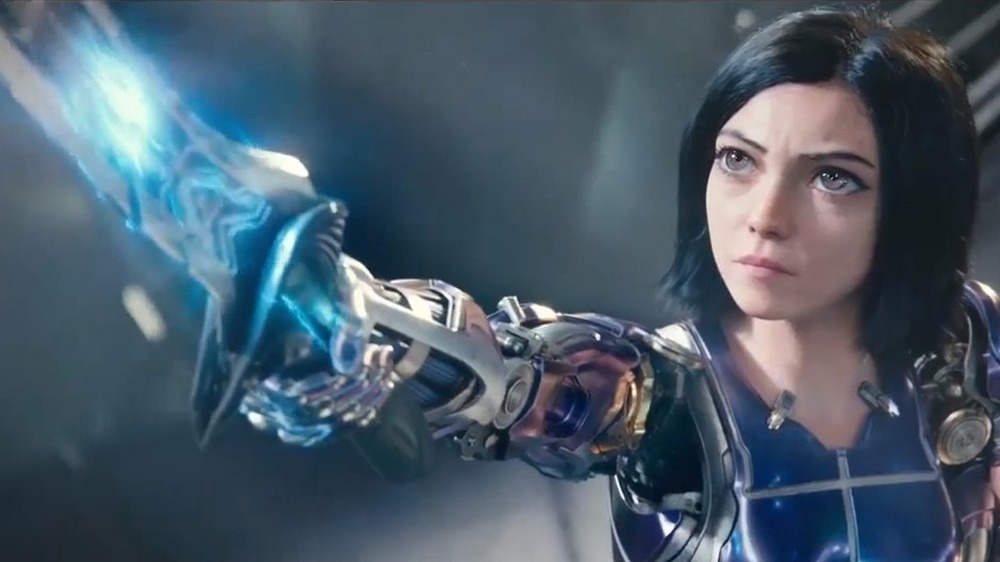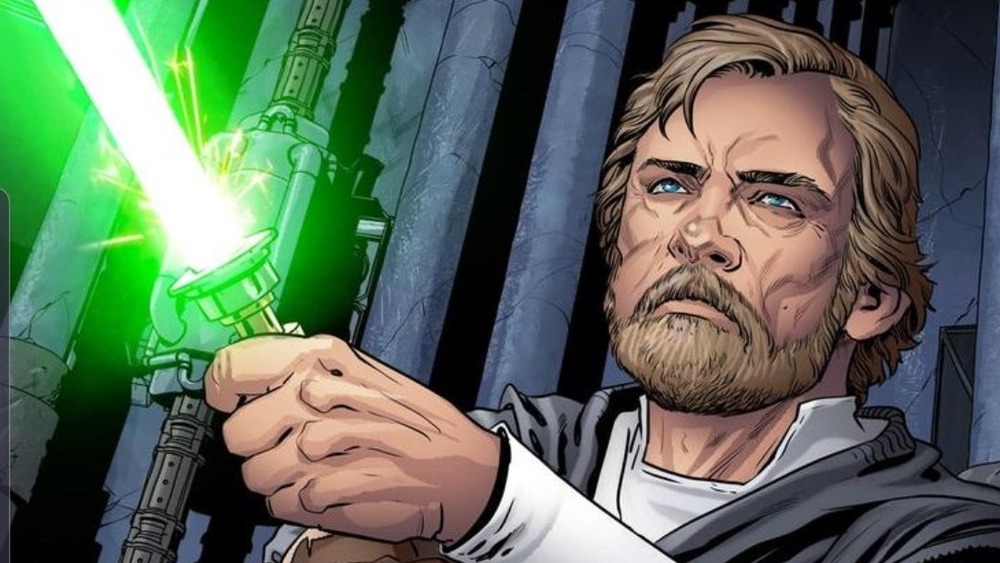Could Alita: Battle Angel's Panzer Kunst Outpower Star Wars' Jedi?
Mark Hamill may be an iconic Hollywood star, but he's also well known for his active presence on social media — especially Twitter. He's not above (lovingly) making fun of Star Wars, sharing cute animal videos, or interacting with his many fans. In October 2020, one of those fans asked him a question: whether or not he believes Luke Skywalker's lightsaber would be a match for the Damascus Blade wielded by Alita (portrayed by Rosa Salazar in Alita: Battle Angel). He answered that he'd not yet seen the movie (via CinemaBlend), but one still has to wonder about the matchup.
For Jedi like Luke, lightsabers are their lives — to paraphrase something Anakin (voiced by Matthew Lanter), repeats to Ahsoka (Ashley Eckstein) in Star Wars: The Clone Wars — but the Force is also always there to guide them: both play a part in Jedi fighting styles.
For cyborgs like Alita, the martial art Panzer Kunst is the name of the game: It allows for combat against a range of opponents and in zero-gravity scenarios. Let's take a closer look at both Panzer Kunst (based on the film and the manga by Yukito Kishiro) and Jedi training (based on what's canonical) to determine the best answer to this question: Would Alita win against a Jedi such as Luke?
Panzer Kunst: a nearly dead, yet deadly, martial art
By the time Alita is restored by Dr. Dyson Ido (Christoph Waltz), most practitioners of Panzer Kunst (called Künstlers) are long gone. She is, therefore, not only a martial artist, but among the last carriers of a centuries-old tradition — one that helps her survive the harsh new world she's been thrust into. Indeed, Panzer Kunst equips Alita to fight armed and unarmed enemies alike, no matter their size. It takes full advantage of the dexterity and strength her cyborg body grants her, allowing for both versatile movement and powerful strikes.
Given time, Alita recalls specific techniques from her Panzer Kunst training years ago. Some are more passive, like Schatten Forgen, which keeps Künstlers in their opponents' blind spots as much as possible, and helps with dodging. Others are more offensive, like Hertza Haeon, which utilizes highly-concentrated kinetic energy to mess with bodily functions. There are also less well-known but extremely effective Panzer Kunst moves, the most dangerous of which is probably Einsatzrhythmen, which boils down to using her own chi to block her enemies' chi, canceling out their assault.
Alongside all these techniques, Alita wields her Damascus Blade, won from rival cyborg Zapan (Ed Skrein) in the film. It's as sharp as sharp gets, able to cut through most anything. Combined with the plasma coating Alita can generate through her resilient Berserker Body, the Damascus Blade is virtually unmatched by anything other cyborgs can throw at her.
Still, Alita is not invulnerable, and despite Panzer Kunst's general applicability, it's not going to work against every opponent ever. As aforementioned, she remembers more Panzer Kunst techniques over time, meaning she could be at a disadvantage if a potential Luke/Alita battle occurs at a point when a particular technique she hasn't remembered yet could've helped her. Generally speaking, though, Alita is not a warrior to be trifled with.
What gives a Jedi their power
Luke is a unique Jedi for many reasons, one of the most prominent being he's among the last of his kind left in the galaxy. Compared to the Jedi who preceded him, his training began extremely late and was limited to the time he spent with Obi-Wan Kenobi (Ewan McGregor and Alec Guinness) and Yoda (Frank Oz). Everything else he learned on his own, but he's no less adept for all that. He built his own lightsaber, defeated Darth Vader (James Earl Jones/David Prowse) in single combat, and he established his own school for the Force-sensitive.
Speaking of which: the Force is Luke's greatest ally here. It's an energy of sorts that "binds the universe together," as Luke himself puts it, and supplies Jedi with their vast array of abilities once they find peace within themselves. One of the most common of those abilities is telekinesis, which can be used to lift or push objects — or enemies — at will. The Force also grants telepathy, future sight, and augments all aspects of a Jedi's physicality. In his time alone on Ahch-To, Luke was able to discover even rarer abilities, like Force projection, through which he can produce an intangible doppelgänger at the expense of his life force.
The Force is what allows Jedi to wield lightsabers so proficiently. Indeed, lightsabers cut through nearly everything: exceptions such as beskar are usually lightsaber-resistant rather than lightsaber-proof. Armed with the weapon and the power of the Force, Luke is a threat to pretty much anyone and anything he comes up against, regardless of the strength or number of opponents.
A Jedi's weaknesses are few and far between, but the temptation to adopt the Dark Side of the Force stands above them all. As the son of Darth Vader, Luke exists in a gray area between the Light and Dark Sides. Another potential weakness for Luke is that he's only flesh and blood. He wields much power as a Jedi, but even the Force's physical enhancements only get him so far.
Alita's Panzer Kunst vs. Luke's Jedi ways
Without enough time to ignite her Damascus Blade with plasma, Luke might be able to cut Alita's weapon in half with his lightsaber, though it's hard to say whether the Damascus Blade alone is (or isn't) lightsaber-resistant. Even sans the blade, however, Alita is a tenacious opponent — even sans parts of her body, she deals major damage to Grewishka (Jackie Earl Haley), who's far larger than she is. That's definitely something to consider: Luke managing to sever one of Alita's limbs in classic Star Wars style doesn't put her out of commission immediately.
What of Alita's Einsatzrhythmen? It's typically used to cancel out chi, so could it do the same to the Force? If so, Luke's Force pushes might be rendered ineffective. If not, Alita wouldn't have much of a defense against the Force, no matter how long she spent taking stock of Luke, which could give him the edge he would need to finish the fight. The ambiguity doesn't help in determining a winner, but chi and the Force are not the same thing, so it may be best to assume that Alita couldn't use Einsatzrhythmen to any great extent.
So what it really comes down to isn't who could draw their weapon faster, but whether Panzer Kunst could outmaneuver the Force. The cyborg martial art is highly adaptable to the situation, relying as much on analyzing opponents as it does on sheer skill. Getting a read on Luke's Force abilities after some scrapping would at least make Alita aware of what he's capable of, but Luke's not going to let his guard down or reveal his hand right away. In fact, Luke's likely to let Alita strike first, gauging her abilities from a more defensive position.
Luke's patience, then, could be the key to victory, assuming he gets some good hits in before he tires out ... because a cyborg like Alita isn't going to exhaust herself. Still, Panzer Kunst's versatility is not to be underestimated. Alita wouldn't need many hits to take down a human like Luke, Force-user or not. So much could happen that Luke's patience advantage is only a slight one — maybe 55-45. It is an advantage, nonetheless, so tentatively declaring Luke the hypothetical winner seems an appropriate way to wrap up.



